

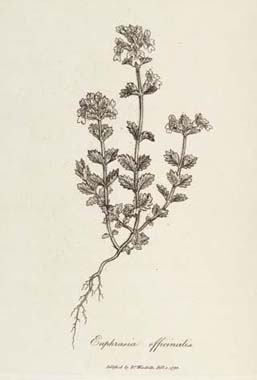

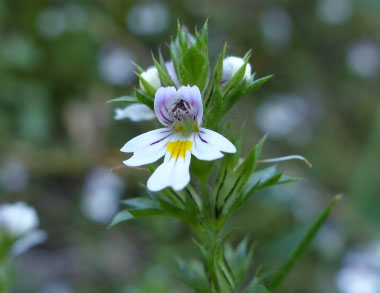
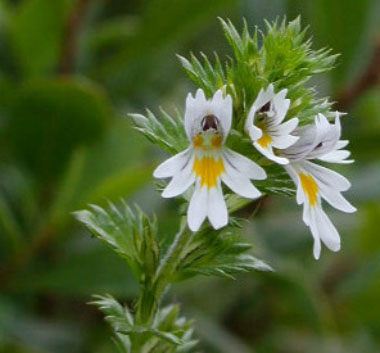
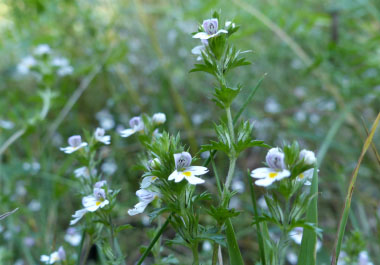


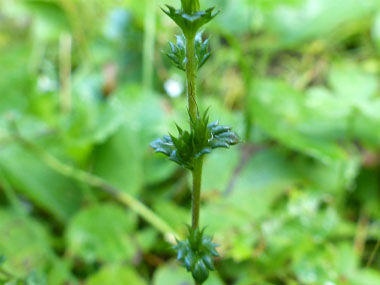
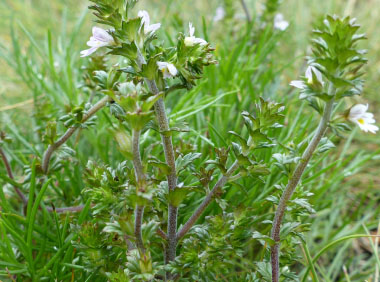
To support our efforts please browse our store (books with health benefits, etc.).
Eyebright is a native British and European plant that has naturalised in many other areas of the world including Canada and the U.S. Eyebright is a semiparasitic plant meaning that it is nourished by the roots of other plants. This annual plant has been used as a folk medicine to treat eye inflammations and infections, coughs, and poor memory since the Middle Ages. Eyebright is a genus of about 450 species of herbaceous flowering plants in the family Orobanchaceae.
Distinguishing Features
Eyebright can be identified by its small, oval-shaped leaves, and small white or lilac flowers. The flowers have a black center, and purple streaks on the petals with a central yellow spot. It can be hard to spot as sometimes this plant does not grow very high and unless it is in bloom it blends in with other plants.
Flowers
Eyebright flowers are primarily white, or lilac with purple-veins. The corolla is two-lipped, its lower, tube-like portion being enclosed in a green calyx, tipped with four teeth. The upper lip is two-lobed and arches over the stamens forming a shelter-like structure. The lower lip is spreading and three-lobed, each lobe being notched. A yellow patch emphasizes the central lobe and purple 'honey guides' on both upper and lower lips - marked streaks of colour - point the way down the throat. It has four stamens, with brown, downy anthers. It blooms from June to September.
 Fields
of Nutrition has medicinal benefits and vitamin/mineral content of Eyebright.
Fields
of Nutrition has medicinal benefits and vitamin/mineral content of Eyebright.
Leaves
Eyebright leaves are usually between 1/2 to 1 cm (1/6” to ½”) long and roughly .6cm ( ¼”) wide. Some of the leaves are narrow and pointed at the end, while others are more rounded at the tip. The leaves grow along with the stem in opposite pairs.
Height
This is a very small plant that grows anywhere from 10 to 25cm ( 4-10”). The stem is erect and wiry, either unbranched in smaller plants, or with several opposite branches in the taller plants.
Habitat
Eyebright can be found throughout North America, Europe, Northern and Western Asia. It prefers grassy areas and meadows. Eyebrights are found in alpine or sub-alpine meadows where snow is common.
Edible Parts
The stems, leaves and flowers are all edible.
Other Name
Meadow Eyebright.
Similar Plants
Euphrasia minima.
Winter Survival Food Handbook

PDF Plant Magazines
Types of Wild Food
Geographic Zones Seasons
Disclaimer
EdibleWildFood.com is informational in nature. While we strive to be 100% accurate, it is solely up to the reader to ensure proper plant identification. Some wild plants are poisonous or can have serious adverse health effects.
We are not health professionals, medical doctors, nor are we nutritionists. It is up to the reader to verify nutritional information and health benefits with qualified professionals for all edible plants listed in this web site. Please click here for more information.
Why Edible Wild Food?
- Food costs are rising
- Free, wild food is readily abundant
- Wild food adds nutrition to your diet
- Wild food can help treat various medical conditions





